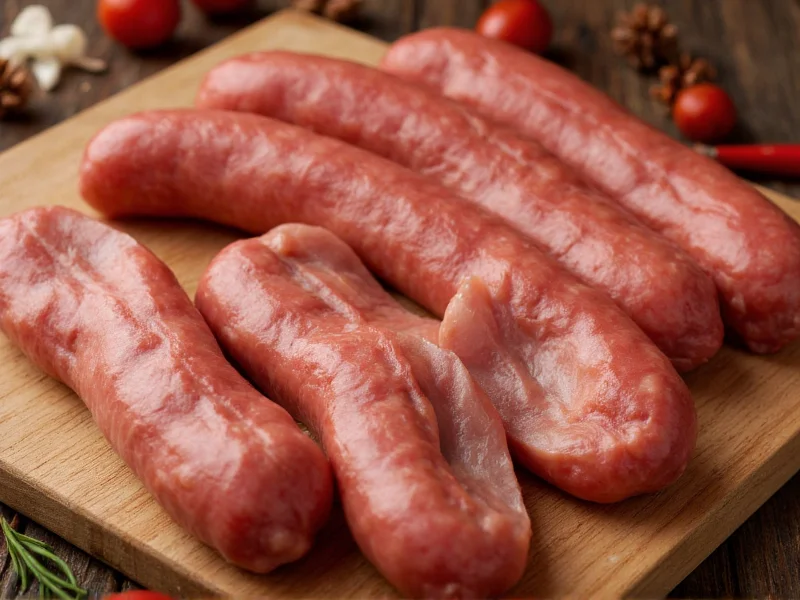Sausage casings serve as the essential outer layer that holds ground meat and seasonings together during cooking. Understanding what sausage skins are made of helps consumers make informed choices about texture, cooking methods, and dietary preferences. This comprehensive guide explores the materials, manufacturing processes, and practical considerations for all sausage casing types.
Natural Sausage Casings: Traditional Animal-Based Options
Natural sausage casings have been used for centuries and remain popular among artisanal butchers and home sausage makers. These casings come from the cleaned and processed submucosal layer of animal intestines, primarily from:
- Sheep intestines - Thin and delicate, ideal for breakfast sausages and small links
- Pork intestines - Medium thickness, perfect for bratwurst and Italian sausages
- Beef middles - Thicker casings used for larger sausages like salami and bologna
The production process involves removing the intestinal lining, thorough cleaning, salt preservation, and careful packaging. Natural casings provide superior texture, allow proper smoke penetration during curing, and create that desirable "snap" when bitten into. Many sausage enthusiasts consider natural casings essential for authentic flavor and texture that artificial alternatives cannot replicate.
Artificial Sausage Casings: Modern Manufacturing Solutions
As sausage production scaled up in the 20th century, artificial casings emerged to meet industrial demands. These fall into three main categories:
| Casing Type | Primary Material | Edibility | Common Uses |
|---|---|---|---|
| Natural | Animal submucosa | Fully edible | Artisan sausages, specialty products |
| Collagen | Processed animal collagen | Mostly edible | Hot dogs, breakfast links |
| Cellulose | Regenerated plant fiber | Non-edible (peeled) | Frankfurters, bologna |
| Synthetic | Nylon or plastic polymers | Non-edible | Large cured meats, cooked products |
Collagen Casings
Manufactured from processed animal collagen (typically bovine hides), collagen casings offer a middle ground between natural and fully artificial options. These edible casings come in various diameters and are widely used for hot dogs and smaller sausages. Unlike natural casings, collagen casings provide consistent sizing and don't require soaking before use. Most collagen casings are fully edible though some thicker varieties might be removed before consumption.
Cellulose Casings
Made from regenerated plant fiber (usually cotton linters or wood pulp), cellulose casings dominate mass-produced sausage manufacturing. These non-edible casings are peeled off after cooking and commonly used for hot dogs and luncheon meats. The production process involves dissolving cellulose in chemicals, extruding it into tubes, and regenerating the fiber structure. Cellulose casings allow for high-speed filling and provide uniform appearance in commercial products.
Synthetic Casings
Constructed from nylon, polyester, or other plastic polymers, synthetic casings serve specialized purposes in large-diameter products like salami and cooked hams. These non-edible casings withstand high cooking temperatures and provide structural support during processing. Food manufacturers remove synthetic casings before packaging the final product.
Vegetarian and Vegan Sausage Casing Alternatives
For plant-based sausages, manufacturers use several innovative casing solutions:
- Seaweed-based casings - Made from alginate extracts, these edible films work well for fresh vegetarian sausages
- Cellulose derivatives - Modified plant fibers that mimic traditional casing properties
- Edible films - Combinations of starches, proteins, and lipids designed to hold shape during cooking
- Skinless production - Many vegan sausages skip casings entirely, using binders to maintain shape
These alternatives address the challenge of creating convincing plant-based sausage products while meeting vegetarian and vegan dietary requirements. Unlike traditional animal-derived casings, these options provide ethical and religious compliance for diverse consumer groups.
How to Identify Sausage Casing Types
Consumers can often determine casing types through visual and textural clues:
- Natural casings appear slightly irregular with visible texture and provide that characteristic "snap" when bitten
- Collagen casings look more uniform than natural but still have some texture and are typically edible
- Cellulose casings produce perfectly uniform sausages with smooth surfaces (often peeled before sale)
- Synthetic casings are only found on large cured products where the casing is removed before packaging
Reading ingredient labels remains the most reliable method. Terms like "sheep casing," "collagen casing," or "cellulose casing" clearly indicate the material used. Products labeled "skinless" typically used cellulose casings that were removed after cooking.
Safety and Regulatory Considerations
All sausage casings must meet strict food safety standards regulated by agencies like the FDA and USDA. Natural casings undergo rigorous cleaning and preservation processes to eliminate pathogens. Artificial casings use food-grade materials specifically approved for direct meat contact.
Manufacturers must clearly label casing types, especially important for religious dietary restrictions (halal, kosher) and allergy concerns. The global sausage casing industry follows standardized production protocols to ensure consistent quality and safety across different products and regions.
Common Misconceptions About Sausage Skins
Several myths persist about sausage casings that deserve clarification:
- Myth: All sausage casings are plastic
Fact: Only specific synthetic varieties use plastic polymers; many casings are completely natural or plant-based - Myth: You must remove all sausage casings before eating
Fact: Natural and collagen casings are designed to be eaten; only cellulose and synthetic casings require removal - Myth: Artificial casings contain harmful chemicals
Fact: All food-grade casings undergo rigorous safety testing and use only approved materials - Myth: Sausage casings significantly alter nutritional content
Fact: Casings contribute negligible calories or nutrients to the final product
Understanding what sausage skins are made of empowers consumers to make informed choices based on texture preferences, dietary requirements, and cooking applications. Whether you prefer the traditional snap of natural casings or the consistency of modern alternatives, knowing the composition helps you select products that best match your culinary expectations.











 浙公网安备
33010002000092号
浙公网安备
33010002000092号 浙B2-20120091-4
浙B2-20120091-4